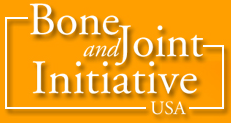 At the outset of the U.S. Bone and Joint Decade in 2002, professional societies and patient advocacy organizations estimated that musculoskeletal research represented a significantly small proportion of all health research despite the prevalence of bone and joint disorders in America. As one key reason, they cited too few clinicians treating patients with these disorders willing to pursue a career in research.
At the outset of the U.S. Bone and Joint Decade in 2002, professional societies and patient advocacy organizations estimated that musculoskeletal research represented a significantly small proportion of all health research despite the prevalence of bone and joint disorders in America. As one key reason, they cited too few clinicians treating patients with these disorders willing to pursue a career in research.
The solution: Experienced researchers involved in the U.S. Bone and Joint Decade (USBJD) developed the Young Investigators Initiative. Today that program has led to 1,066 new musculoskeletal research studies by 202 newly-funded investigators. Funding for these studies totals almost $270 million.
It is a strong effort since YII was established in 2005. Funding for musculoskeletal research is estimated to represent less than 2% of all healthcare research funding in the United States, yet 18% of visits to healthcare professionals are for bone and joint disorders and that represents 16.3% of costs.
Research is the solution to better understanding these disorders, as well as how to prevent, manage disorders and develop better treatments which can ultimately lower their burden on society. It’s a situation likely to get worse with the increasing numbers of baby boomers reaching their senior years.
That is why members of the USBJI (formerly the USBJD) decided the most effective contribution the organization could make to this challenge would be to develop a pipeline of funded young investigators focused on musculoskeletal research. Dr. Nancy Lane formed a team to find the best way to accomplish this. Initially the focus was on the lack of clinician-scientists. The Young Investigators Initiative was born, and the USBJI’s counterpart in Canada, Bone and Joint Canada, joined the effort. Launched as a grant-writing workshop in 2005, the program evolved into much more than that. It has become a grant mentoring and career development program.
What made this possible? The USBJI and BJC point to a number of factors. The commitment made by faculty to mentor participants for a long as it takes for them to land funding for their research study. Faculty, all experienced funded researchers who have sat on study sections, often note that program participants will learn in about a year or two what it took them ten or more years to learn.
A second factor, not fully recognized at the start of the program, are the benefits of interaction among different musculoskeletal specialties. While some specialties might feel more comfortable learning the tools of the research trade alongside peers of their own specialty, YII participants quickly benefit from perspectives on their proposed studies from other specialists. Not only that, collaborations not foreseen have been formed beyond the program itself. In past years, basic scientists were welcomed into the program, leading to more interaction and perspectives as well as a team approach to patient care.
Vital to the program’s success has been the support over the years from several member organizations: the AAOS, AO North America, APTA, ASBMR, MTF, NATA, the National Institutes of Health (NIH), and companies including Baylis, Lilly, Medtronic of Canada, Zimmer Biomet. Funding achieved by participants has come from the NIH, the Canadian Institutes of Health Research (CIHR), and a multitude of funding agencies, organizations and companies. While NIH and CIHR are seen as the gold standard most participants aim for, young researchers come to realize there are stepping stones, and first have obtained multiple grants from other funding organizations. These can lead to important relationships which may endure throughout their careers. With their research successes, these young investigators are rising in their professional spheres and becoming our thought leaders.
The USBJI thanks the Young Investigators for applying to the program and congratulates them on their successes. We thank their department heads who nominated them, YII faculty who have contributed so much, and those who have provided the financial support to make all this possible.
Today, there are 202 new funded investigators in our community working on musculoskeletal studies building their careers as a result of this program. Their ability to develop well-structured and highly competitive research proposals will surely lead to raising that proportion of research into the disorders that concern us, and improving patient care.
For more information about this program:
Website: www.usbji.org/programs/yii
Email: [email protected]
